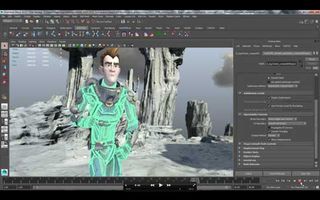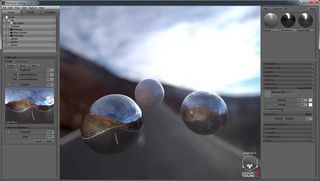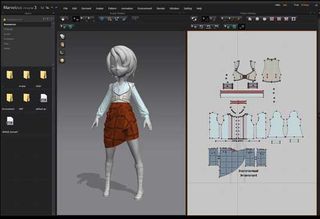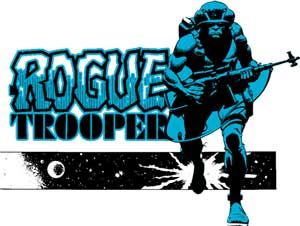The 5 hottest new 3D tools for 2014
As computers get more powerful, here are the tools you need to take advantage.
This article is brought to you in association with Masters of CG, a new competition that offers the chance to work with one of 2000AD's most iconic characters. There are big prizes to be won, so enter today!
We're halfway through 2014 already, and it's already proving to be an exciting year in 3D content creation.
As computers have become more powerful, 3D application developers have not been slow in making the most of this new power available and harnessing it to provide a range of new tools and new methodologies.
These will potentially have a huge impact for streamlining artists workflows as well as providing whole new ways of creating. From new modelling techniques, through to making your 3D creations 'real' 2014 is shaping up to be a bedrock year for 3D. Here are our five hottest picks from the new releases so far, plus some other tools in the same fields that are well worth checking out...
01. OpenSubDiv by Pixar

One of the most exciting advances in 2014 is one of the most immediate. Working with complex models in a 3D viewport has (dependant on your application) tended to be a process which has depended on using simple model views or proxy animations especially when animating so that you can get close to your desired frame rate in your viewport window.
OpenSubDiv is a new method of Sub-Dividing 3D models to provide high res meshes in your viewport which play back at a much higher frame rate than was previously possible.
This is a huge timesaver, especially with organic and cloth shapes. OpenSubDiv which was developed by Pixar and is designed to make the most of GPU and CPU acceleration as it can, so having a big powerful graphics card is advised.
Get the Creative Bloq Newsletter
Daily design news, reviews, how-tos and more, as picked by the editors.
As OpenSubDiv is free and open source, developers can integrate the OpenSubDiv libraries into their 3D applications. Autodesk has integrated OpenSubDiv into Maya 2015, and Blender is demoing the feature for an upcoming release.
02. ToolBag by Marmoset

One of the most exciting developments in 3D in the past couple of years has been the growth of GPU (Graphic Card) rendering, especially with unbiaised render engines.
Unbiaised render engines such as Maxwell Render treat light as if it was physically real. While this produces stunning images, it was until recently slower than 'biaised' render engines (which includes V-Ray) which have a myriad of settings to create the best looking renders as quickly as possible.
GPU acceleration of unbiaised engines has changed this, bringing render times down to levels similar to or indeed faster than traditional 'biased' methods. The catch, though, has been that scene and texture size is determined by how much memory is on your GPU, which tends to be a lot less than your computer
Octane by Otoy has been at the forefront of Unbiaised GPU render engines and with its next release it will use all of your computer's resources to allow bigger scenes to be worked on and move GPU rendering into the same space as traditional biased engines.
Rendering in real time for game development and texturing work is also seeing huge leaps forward, thanks to advances in your graphics card, thanks to applications like ToolBag by Marmoset which allow you to view your models in realtime and adjust your textures to perfection before you send them to a games engine
03. Bifrost in Maya

The increased power of computers mean that tasks that could once only be done by studios are now within the possibilities of a freelancer with a small render farm, available either in their studio or in the cloud. One area that has received a huge leap forward thanks to this power is particle simulation, whether it be for Effects VFX such as smoke or fluid simulations.
Standalone applications like Realflow, as well as plugins such as X-Particles for Cinema 4D or the Houdini engine, have increased the range of possibilities available for artists. But ideally having these tools developed alongside 3D applications would be ideal. Autodesk have realised this with Bifrost, which is a result of their purchase of Niaid.
Currently available in Maya 2015, Bifrost allows the creation of complex fluid simulations, which can be integrated within your Maya scene. It's early days - for example, currently Bifrost can't use multiple machines yet. But it's already quicker than Naiad on a single machine and produces better results. And as it integrals directly within Maya the simulation can be used to drive geometry instead of particles allowing a huge range of creative options.
Autodesk intends to move forward quickly with Bifrost and expect to hear more throughout the year. For an in-depth look this excellent article delves deeper.
04. Photoshop CC's 3D printing tools

2014 is the year that 3D printing has gone mainstream: even supermarket chain Asda offers a 3D printing service). 3D software developers have embraced this movement and have increased the tools available to get their models made into... real models.
The cost of 3D printing is falling rapidly as well, as the $199 Kickstarter funded Micro ably demonstrates. For the cost of a laptop you can get yourself a professional grade 3D printer to make your dreams a reality.
Software support is also on the rise. The Foundry has partnered with Makerbot to allow easier creation of 3D prints through Modo, which already has the excellent Mesh Fusion modelling plugin which can make airtight 3D meshes.
Don't worry, though, if you don't want to learn what can seem like a daunting 3D application. Photoshop CC has had its existing 3D workflow optimised with a focus on 3D printing and now can add rafts and scaffolding to your 3D model. Together with partnerships with MakerBot and Shapeways, this has made it easier than ever before to 3D-print your model in the studio or online, without having to leave your existing software of choice.
05. Marvelous Designer

We were all suitably wowed by the amazing VFX work by Framestore on Gravity, and one of the standouts had to be the Astronaut suits, which were faultless. Thanks to tools like Marvelous Designer, fabric creation for models have become vastly more intuitive. This it works as if you were a real tailor, so traditional skills like seams and patterns and how materials drape over the body all of sudden are as important as polygon flow. Accessories like buttons can be added, and it has revolutionised Fabric workflows in many areas of 3D for films like the Hobbit trilogy and many top games are benefitting from it as well.
What about the figures to hang your clothes on? Well, MakeHuman is a fantastic new tool for doing exactly that. MakeHuman is open source so its free for any kind of use, and has a fantastic range of tools to provide you with a unique figure very quickly which can be exported to programmes such as Marvellous Designer, or ZBrush for more refined sculpting.
Conclusion
The one thing to note with these tools is that they are a making 3D more accessible, provide quicker feedback or using analogue methodologies, which mean that anyone whether an existing 3D artist or a designer new to 3D will find it easier than ever before to give a new dimension to their work.
Words: Mike Griggs
Win a trip to Los Angeles

Masters of CG is a competition for EU residents that offers the one-in-a-lifetime chance to work with one of 2000AD's most iconic characters: Rogue Trooper.
We invite you to form a team (of up to four participants) and tackle as many of our four categories as you wish - Title Sequence, Main Shots, Film Poster or Idents. For full details of how to enter and to get your Competition Information Pack, head to the Masters of CG website now.
Enter the competition today!

Thank you for reading 5 articles this month* Join now for unlimited access
Enjoy your first month for just £1 / $1 / €1
*Read 5 free articles per month without a subscription

Join now for unlimited access
Try first month for just £1 / $1 / €1
The Creative Bloq team is made up of a group of design fans, and has changed and evolved since Creative Bloq began back in 2012. The current website team consists of eight full-time members of staff: Editor Georgia Coggan, Deputy Editor Rosie Hilder, Ecommerce Editor Beren Neale, Senior News Editor Daniel Piper, Editor, Digital Art and 3D Ian Dean, Tech Reviews Editor Erlingur Einarsson and Ecommerce Writer Beth Nicholls and Staff Writer Natalie Fear, as well as a roster of freelancers from around the world. The 3D World and ImagineFX magazine teams also pitch in, ensuring that content from 3D World and ImagineFX is represented on Creative Bloq.
